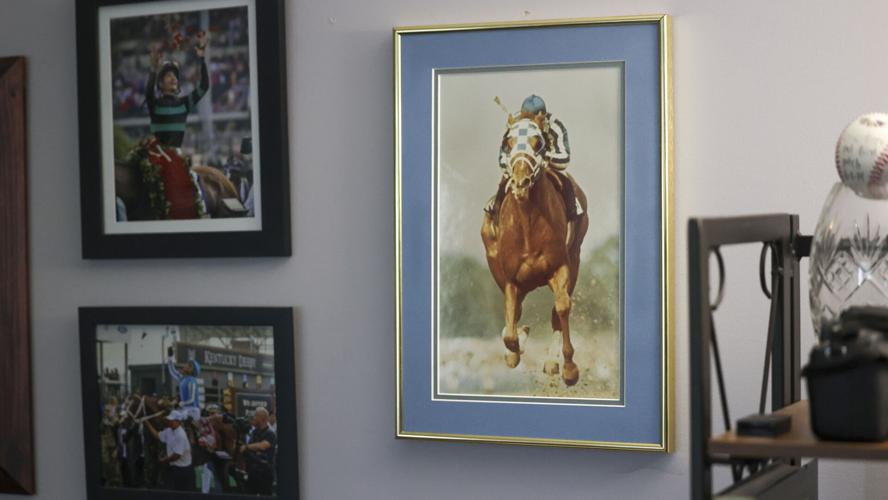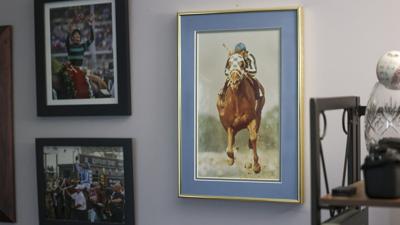LOUISVILLE, Ky .(WDRB) -- The photograph has hung in every home office I’ve ever had.
It shows Secretariat in full flight — charging down the stretch at Churchill Downs in the 1973 Kentucky Derby. I believe it is the photo that ran inside Sports Illustrated, a double-truck, we used to call it in the quaint days of actual printed publications.
The picture, I believe, was taken by famed photographer Neil Leifer. The story, as related to me by my father, was that Cawood Ledford asked for a print of it. And Ledford made a print and gave it to my dad, who somewhere along the line got it signed by Penny Chenery.
That original hung in his office for most of my childhood. And still does. At some point, my dad made a print for me, which has been framed and hanging wherever I’ve gone. It’s faded, a print of a print of a print.
Nearly every day of my journalism life, I’ve looked up at Secretariat, a tremendous machine, thundering down the stretch.
But it’s only now, a day after the passing of jockey Ron Turcotte, that I took a minute to realize what I wasn’t seeing.
Between the great colt’s ears, only a blue cap is visible. Above his head, some shoulders and arms, in striped silks, a crop at the ready but unused against his shoulder.
It is Ron Turcotte.
He is there, but not there. An extension of the horse.
We talk about Secretariat’s greatness – the speed, the margin, the records – and we should.
It’s easy to miss the man sitting there statuesque, his face invisible between the great animal’s ears, as just along for the ride.
That is a mistake.
The architect in the saddle
Turcotte, who died Friday at 84, was born in New Brunswick, Canada, and grew up in a 12-child logging family with no running water. He dropped out of school at 14 to go to work with his father. Because he was too small to be of much help with an axe, they put him to work with horses. He showed up at Woodbine Racetrack one day with little idea what a jockey even was.
He wound up leaving the sport with some of the most well-known wins in its history.

Ron Turcotte poses next to a statue of him and Secretariat in Grand Falls, New Brunswick, Canada, on May 13, 2013.
Turcotte rode in 20 Triple Crown races and won six of them. He was the first jockey since 1902 to win back-to-back Derbies. And in 1972, aboard the nervous Riva Ridge, he helped a would-be champion overcome his fear of crowds — by designing his workouts to simulate race-day traffic.
Had Riva Ridge handled the mud in the 1972 Preakness, Turcotte might’ve won back-to-back Triple Crowns. He was that skilled.
“I enjoyed it,” Turcotte once said. “To me, it was a picnic around the racetrack. It was much easier than cutting lumber.”
Most famously, he rode Secretariat in 18 of his 21 races.
And while Secretariat’s team was full of famous names — Chenery, a pioneer among women in sport; Lucien Laurin, the eccentric and brilliant trainer — Turcotte’s role was no less central.
“I had no orders or restrictions on how to ride Secretariat,” Turcotte recalled of his famous ride in the 1973 Preakness in a Q&A posted by Secretariat.com. “… I know Penny later told the media, ‘Ronnie rode him just like we planned.’ But I can tell you the plan was just between Secretariat and me.”
That included “The Move” — his bold first-turn sweep in the 1973 Preakness. It was instinct, not orders.
“They tried to slow the pace,” Turcotte said. “It was my chance to surprise the field and catch everyone sleeping. All I had to do was chirp to him on the first turn then stay quiet and in motion and try to be part of him.”
It’s the kind of thing that can get a jockey a dressing down after the race if it doesn’t work out. But if you’re sitting on the colt in the winner’s photo, it’s hard for them to dress you down.
The feel of greatness
Turcotte said riding Secretariat was like pressing the accelerator on a sports car. There was always another gear. Always more. Most horses, if they’re good, have one burst. Great ones two. Secretariat had more than that.
“You could really feel it,” he said. “The beauty of it is that when he was right … I could do it at any time in the race, then get him to relax and do it again.”
That’s not just horsepower. It’s horsemanship. It’s trust. It’s partnership.
In the 1973 Belmont Stakes, Secretariat ran 1½ miles in 2:24 flat — a time untouched in 52 years. He won by 31 lengths. At the wire, Turcotte peeked back — not at the field, but at the clock. He was no longer racing against other horses. He was racing against history.
"Many horsemen have seen Turcotte looking at the timer and now they’re looking at it too,” the great William Nack wrote in his book Secretariat. “He is racing the clock, his only competitor, and he is beating it badly as he rushes the red horse through the final yards.”
Five years later, at the same track, Turcotte’s ride ended. His mount clipped heels and Turcotte was thrown headfirst, vertebrae crushed “to powder” he said. He never walked again.
But he never left racing.
He spent the next 40 years as an advocate for the Permanently Disabled Jockeys Fund, appearing at tracks, sharing stories, raising money.
He wore Secretariat’s silks on his lapel. He asked for leg casts in blue and white after a car accident broke both legs.
I was fortunate to interview him at Belmont in 2014. That's around the time when he had rattled the cages of Churchill Downs after he came for the Derby and got little accommodation in the way of access or hospitality.
“They treat my treasured Hall of Fame pin as an obsolete relic,” he said. “I suspect they view me and many of my fellow riders … the same way.”
His words resonated with quite a few people, and Churchill took note.
“While his courage as a jockey was on full display to a nation of adoring fans during that electrifying time, it was after he faced a life-altering injury that we learned about the true character of Ron Turcotte,” New York Racing Association president and CEO David O’Rourke said Friday. “By devoting himself to supporting fellow jockeys struggling through similar injuries, Ron Turcotte built a legacy defined by kindness and compassion.”
The man in the photo
Turcotte called Secretariat “a very intelligent horse … always ready to give you everything he had.”
The same could be said of Turcotte.
When Secretariat playfully bucked him off after a workout one day, Turcotte landed on his feet. The horse didn’t bolt. He stood there, waiting.
“He looked at me like, ‘Hey, what are you doing down there?’” Turcotte said. “I passed the reins back over his head, patted him on the neck, grabbed a handful of mane, and jumped back on.”
That’s the image I’ll keep now — not just the man in the photo between Secretariat’s ears, but the man who knew how to talk to greatness, and when to let it run.
Ron Turcotte wasn’t just along for the ride.
He made the ride possible. He helped to write one of the great stories in the history of thoroughbred racing. And as its final living link, helped keep it alive.
To me, he’s a valuable lesson -- to see the whole picture, before it’s too late.
Related Stories:
'There's only one Secretariat' | The American phenomenon forever deemed a Superhorse
Who would have beaten Secretariat? Seattle Slew, says Jean Cruguet
Curator picks Top 5 unforgettable moments that shaped Kentucky Derby history
Kentucky Derby 151: The Greatest 2 Minutes in Sports, by the numbers
Copyright 2025 WDRB Media. All Rights Reserved.



